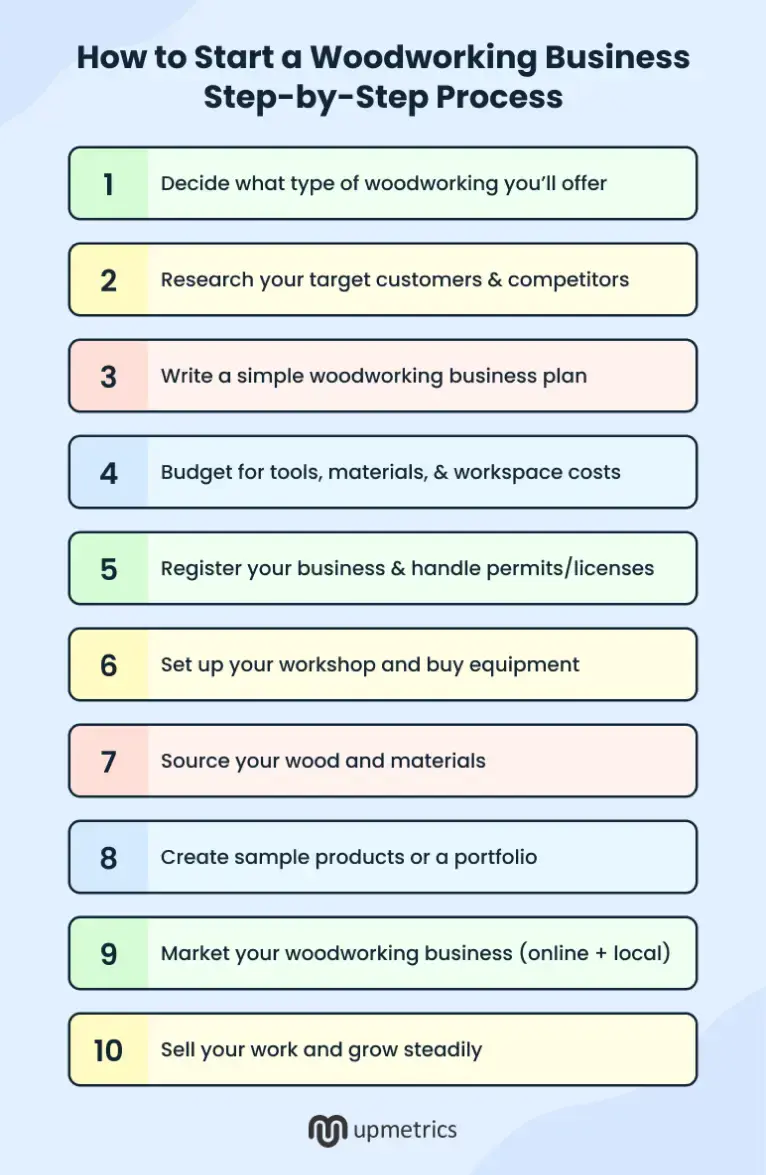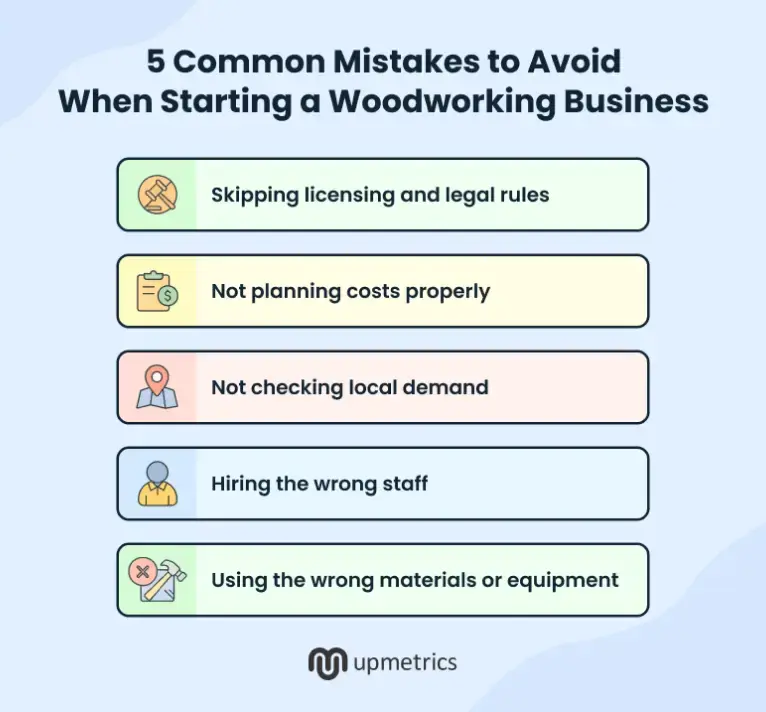I’ve talked to so many people who love woodworking but haven’t taken the leap yet—and honestly, I get why. Pricing feels scary.
The business side feels fuzzy. And figuring out where to even sell? Yeah, that can stop anyone in their tracks. Totally normal worries.
But here’s my take: you don’t need every answer on day one. I’d start small—get the basics legal, pick one lane, make a few repeatable products, and sell to real people. From there, you’ll learn fast and adjust as you go.
That’s exactly what this guide is about. It’s the same path I’d follow myself. I’ll walk you through setting up your shop, picking what to sell, pricing with profit, and landing your first customers. Then, step by step, we’ll grow from there.
By the end, you won’t just think about how to start a woodworking business. You’ll actually know how to set up your shop, price your products, find your first customers, and launch with confidence—without second-guessing every step.
Let’s get started!
Key Takeaways
- Starting costs range from $5k–$15k at home to $20k–$50k+ for a shop.
- Focus on one main product area to keep things clear.
- Good materials, better products, and happier customers.
- Show your work with a small portfolio and clear photos.
- Sell steadily, give good service, and growth will follow.
How much does it cost to start a woodworking business?
If you’re working from home, you can set up a decent workshop for $5,000–$15,000. If you want a full shop with space, better gear, and branding, expect $20,000–$50,000+.
I break costs into two buckets:
- One-time costs: tools, benches, setup, branding, licenses.
- Ongoing costs: wood, supplies, repairs, rent, utilities.
How to start a woodworking business: Step-by-step process
Start small, stack wins, and grow from there. Here’s how I’d do it: make a simple plan, set up a clean workspace, build a few samples you’re proud of, and then start selling.

Once you’ve got that flow, growth comes naturally.
Step 1: Decide what type of woodworking you’ll offer
One thing beginners often do is try to cover everything at once—furniture, décor, cabinets, custom builds, even wholesale. On paper, it sounds good, but in practice, it usually causes problems. Customers get confused, pricing feels unclear, and the workshop becomes harder to manage.
Here are the common options to choose from:
- Furniture – Tables, chairs, beds, or simple storage pieces.
- Home décor – Shelves, picture frames, wall art, or smaller items.
- Cabinets – Kitchen or bathroom builds—higher ticket but more skill-heavy.
- Custom builds – Rewarding, but time-heavy and harder to scale.
- Wholesale parts – Suitable for bulk orders if you prefer production runs.
That’s why, at the beginning, it’s better to stick with one main area. By focusing on one, you can explain your work more clearly, market yourself with confidence, and build a brand that people remember.
To choose, start with two questions: Do you prefer big projects or smaller, detailed work? And what are people around you—or online—already paying for?
The best choice is where those two overlap. If you only follow passion, sales may be slow. If you only chase demand, burnout is likely. But when passion and demand meet, that’s where your woodworking business has the strongest start.
Step 2: Research your target customers and competitors
After you decide what kind of woodworking you’ll do, the next step is to check your market. This means knowing your customers and seeing what other woodworkers near you are making.
Start with the people around you:
- Urban buyers often look for compact furniture and storage.
- Families usually want sturdy tables, shelves, and home goods.
- Businesses may order custom jobs or buy in bulk.
When you know your customers, you’ll know what to build. Now, check other woodworking shops near you. Look at what they sell—furniture, small décor, or custom builds. Notice their prices and see which items keep selling out. If something disappears fast, that shows there’s real demand.
You can also read reviews. If buyers complain about weak joints or poor finishes, that’s your chance to do it better and stand out.
Finally, look for gaps. Maybe:
- No one is offering durable family furniture.
- Prices are too high for simple goods.
- Customer service isn’t great.
These gaps are your chance to step in and serve buyers better. By doing this research, you’ll know what people want and how your woodworking business can be different.
Step 3: Write a simple woodworking business plan
Putting together a woodworking business plan for you doesn’t need to feel overwhelming. You’re not writing a book—just a short guide that lays out how you’ll run the shop and what success will look like.
Too many people jump in without thinking about basics like who they’ll sell to, how much their products should cost, or even how they’ll keep up with demand. That usually leads to stress later.
Here’s what I suggest you to include:
| Plan Section | What to Include |
|---|---|
| Your target customer | Be clear. Are you selling to homeowners, businesses, or doing only custom jobs? Pick one main lane to start—it saves a lot of stress. |
| Your products & pricing | Decide if you’ll stick with small items (like shelves or décor) or go big with furniture. Prices should cover costs and leave enough profit to reinvest. |
| Your material sourcing | Figure this out early. Will you buy from lumber yards, wholesalers, or use reclaimed wood? Reclaimed wood can save money and give projects more character. |
| Your production capacity | Be honest. How many pieces can you realistically make in a week or month with your setup? Overpromising is a mistake I’ve seen too often. |
| Your marketing & sales plan | Think about where buyers will come from. Online platforms like Etsy work well, but local fairs and partnerships can be just as valuable. |
This can fit on just one or two pages. Unless you’re applying for bank financing, you don’t need a long, detailed report. The idea is to give yourself a roadmap so you’re running your business with intention instead of reacting as you go.
Not very good at writing? Need help with your plan?
Write your business plan 10X faster with Upmetrics AI
Plans starting from $14/month

Step 4: Budget for tools, materials, and workspace costs
Before you set up your woodworking business, I want you to ask yourself:
How much money do I need to get my shop running?
Can I start small at home, or do I need to plan for a bigger workshop?
Making a budget will give you the answers. It shows what you must spend upfront and helps you avoid running out of money later.
Here’s a rough idea of the costs for a home workshop and a small commercial:
| Item | Home Workshop | Small Shop |
|---|---|---|
| Tools & Equipment | $3,000–$7,000 | $10,000–$20,000 |
| Materials (wood, hardware, finishes) | $1,000–$2,000 | $3,000–$6,000 |
| Workspace Setup | $1,000–$2,500 | $5,000–$10,000 |
| Rent & Utilities | $0–$500/month | $1,000–$2,000/month |
| Licenses & Permits | $500–$1,500 | $1,500–$3,000 |
| Marketing | $300–$800 | $1,000–$2,000 |
| Total | $5,000–$15,000 | $20,000–$50,000+ |
If your budget is tight, spend first on tools, wood, and a simple workspace. Extras like signs, ads, or extra storage can wait until later.
Making a budget gives you a clear picture of money, shows whether you need outside funding, and helps you move forward with confidence.
Step 5: Register your business and handle permits/licenses
After you plan your costs, the next step is to make your woodworking business legal. This means you need to register your business and get the right licenses.
First, choose a business structure. You can run it as a sole proprietorship. This is the easiest way, but you take all the risk. I suggest an LLC (or a corporation if you’re thinking bigger) because, yeah, it costs a bit more, but it protects your personal money.
Next, register your business name. Pick a name that is short and easy to say. Make sure no one else is already using it in your area.
Now, apply for the license you’ll need. Every woodworking business should have a basic business licenses. Depending on where you work, you may also need:
- Zoning or home occupation permit (if you’re running from a garage or shed)
- Sales tax registration (if you’re selling directly to customers)
- Fire and safety clearance (in some places)
Don’t forget insurance. Personally, I feel this is just as important as your tools:
- General liability insurance
- Property insurance for your tools and shop
- Workers’ compensation if you hire staff
Some cities may also send inspectors before you open. They might check zoning rules, fire safety, or workshop setup. Personally, I think you should get all of this sorted early, instead of panicking a week before your first sale.
Once you understand, it’s time to make sure your setup is complete. Use this quick checklist to stay on track:

By the end of this step, your woodworking business will be officially registered and ready to operate legally.
Step 6: Set up your workshop and buy equipment
After you get your licenses and paperwork sorted, the next step is to set up your workshop. I can’t tell you how much the layout and feel of a shop matter. A clean and simple setup makes the work easier, safer, and more enjoyable.
Start with the space. A garage or shed works well for beginners. It’s affordable, close by, and perfect for making those first few products.
But if you plan to grow or meet clients, a bigger commercial shop is a better choice. It gives you more room and looks more professional.
| Workshop Type | Best For | Pros | Cons |
|---|---|---|---|
| Home (garage/shed) | Small setups or part-time work | Low cost, easy to access | Small space, noise issues, zoning rules |
| Commercial space | Bigger businesses, higher output | More space, looks professional, client-friendly | Higher rent, extra permits, more bills |
Now, think about the setup you need:
- Dust collection – To keep the air clean.
- Good airflow – For safety and comfort.
- Tool storage – Keep tools neat and close at hand.
- Easy access – Make sure wood and deliveries can come in smoothly.
- Good lighting – Bright light helps you see details and makes the shop feel better.
Oh, and safety—I can’t forget that. Clear walkways, covered wires, and safe storage make a big difference. Heavy items should always go on lower shelves.
Step 7: Source your wood and materials
The quality of wood and supplies often decides how good and long-lasting the final products will be. Using strong, well-sourced materials helps create pieces that look great and last, which customers quickly notice. On the other hand, poor-quality materials waste money and risk leaving buyers disappointed. That’s why choosing the right source is so important.
| Source | Why use it |
|---|---|
| Lumber yards | Regular supply of hardwoods and softwoods in many grades. |
| Wholesalers | Lower prices when you buy in bulk, useful for big orders. |
| Reclaimed wood | Eco-friendly, unique look, popular with customers who like sustainable products. |
| Local suppliers | Sawmills or farms may offer affordable or specialty wood. |
Wood is only part of the setup. Small items like screws, hinges, glue, and finishes play just as big a role in how sturdy and polished the final product feels. Many businesses buy these in bulk to save money, though storage space should always be considered.
Reliable suppliers can be as important as the wood itself. The right ones offer fair prices, consistent delivery, and sometimes even special stock on request. Building these relationships helps ensure materials don’t run out, keeping production smooth and customers satisfied.
Step 8: Create sample products or a portfolio
This is where many new woodworkers pause and wonder, “I don’t have a portfolio… why would anyone trust my work?” That worry is totally normal.
But here’s the truth: you don’t need a huge catalog of work to start. You just need a few examples that highlight your skill and style.
Here’s how to build early trust:
- Pick your strongest pieces. Choose 3–5 items that showcase your craftsmanship—whether that’s a sleek cutting board, a sturdy table, or a detailed shelf.
- Capture clear photos. Use natural light and a plain background. Shoot each piece from multiple angles so buyers can truly appreciate the details.
- Stay focused. If your specialty is furniture, showcase furniture. If it’s home décor, stick to related items. Too much variety can dilute your messaging.
- Keep it simple. Share your portfolio on Instagram, Etsy, or a clean website. For local buyers, a small photo booklet works wonders.
A tidy, focused portfolio does more than look professional—it helps convert interest into real orders.
For instance, take the story of Po Shun Leong, who started by selling simple wooden boxes at local craft shows. He began with just a few pieces, then refined his craft into intricate architectural designs. His focused portfolio earned him awards and recognition in prestigious furniture competitions. Over time, Leong built a reputation rooted in a clear, consistent showcase of his skill.
Step 9: Market your woodworking business (online + local)
Once your workshop is ready, the next step is to show your work. If people don’t see your products, they won’t know to buy them. Simple marketing ideas can help bring in new customers and keep old ones coming back.
Start with social media. Post clear photos on Instagram so people can see your finished pieces. Share short clips on TikTok that show the making process. These platforms are free and help you reach buyers quickly.
Next, list your items on online marketplaces. Etsy is popular for handmade products, and having your own website adds even more trust. A clean photo of a finished table or shelf often convinces buyers more than words alone.
A clean image of a finished table or shelf builds more trust than words alone. For example:

- For example, Builderology shows how small woodworking businesses attract new customers by posting on Instagram, pinning projects on Pinterest, and creating simple content that tells the story behind each piece (builderology.com)
- Plan some opening offers when you launch—like small discounts or free delivery on first orders. These create interest and make people want to try your work. Later, you can think about loyalty rewards, bundle deals, or seasonal specials to keep sales strong.
- You don’t need to spend a lot of money. Simple and regular promotion is enough to make your woodworking business known and trusted.
Step 10: Sell your work and grow steadily
When your shop is ready and you have products, start selling. The aim is not just to get first sales but to keep growing.
Begin small. List items on Etsy, Facebook Marketplace, or your own site. You can also join local fairs to meet buyers. For bigger pieces like tables, talk to furniture shops or local designers who might want custom work.
Keep customers happy. Deliver on time, keep your quality good, and be polite. Buyers who are happy will often return and tell others about you. Word of mouth and reviews are the easiest way to grow.
As sales rise, check your process. Can you work faster without losing quality? Do you need extra help? Do you want to add more products? Growth is not just about making more. It’s about creating simple systems that save time and make work easier.
Step by step, steady sales turn your woodworking into a real business, not just a hobby.
5 Common mistakes to avoid when starting a woodworking business

Starting a woodworking business is a big step, and I’ve seen how the way you begin can make all the difference. Over time, I’ve noticed many new woodworkers fall into the same traps. They seem small at first, but they can slow you down or even hurt your business. Here are five mistakes I recommend avoiding—and what to do instead:
1. Skipping licensing and legal rules
I’ve met people who tried selling without the proper licenses, permits, or safety checks. It always ends badly. Regulators fine you fast, and customers walk away.
So, ensure you get all required licenses and permits before opening. Check local zoning rules, complete safety inspections, and get insurance. Being fully legal builds trust with customers right away.
2. Not planning costs properly
Many beginners think only about setup costs—like tools and wood. But the real test comes with monthly expenses: rent, utilities, insurance, and marketing. I’ve seen shop owners drain their savings because they didn’t plan for both.
So, plan for all one-time and ongoing costs and ensure you have at least 6–12 months of operating expenses covered. Keep track of income and expenses carefully from day one.
3. Not checking local demand
Opening in the wrong spot is risky. If an area already has plenty of shops selling the same things, finding buyers becomes a struggle. I’ve watched this mistake sink good woodworking businesses.
That’s why you should research your area before committing. Look at what people buy, the prices they pay, and existing options. Find gaps you can fill, like custom furniture or eco-friendly décor, to stand out.
4. Hiring the wrong staff
Your team is the face of your workshop. If they aren’t skilled, trained, or reliable, customers will notice immediately. I’ve seen one poor hire undo months of effort.
So, hire carefully. Check references, test skills, and ensure staff follow safety standards. Offer regular training and set clear expectations for quality and deadlines.
5. Using the wrong materials or equipment
Some new owners buy the cheapest wood or tools just to save money. Unsafe gear or poor materials can break, cause accidents, or turn buyers away. Customers notice.
Hence, invest in quality wood, safe equipment, and reliable tools. Inspect everything regularly. A well-set-up shop not only keeps work safe but also shows customers you take quality seriously.
Avoiding these mistakes—and following these fixes—will help you start on the right path and build customer trust from day one.
Final thoughts
Starting a woodworking business is a good way to earn steady money from your craft. You’ll enjoy making furniture or home items that people can really use. At the same time, you’ll face costs, fair pricing, and competition. That’s just part of business.
A simple plan helps. With Upmetrics, you can build a woodworking plan that keeps you on track. It shows where your money goes, helps with budgeting, and saves you from costly mistakes.
Always aim for good work, fair prices, and kind service. When people see that, they’ll trust your business and share it with others.
The Quickest Way to turn a Business Idea into a Business Plan
Fill-in-the-blanks, AI-assistance, and automatic financials make it easy.


